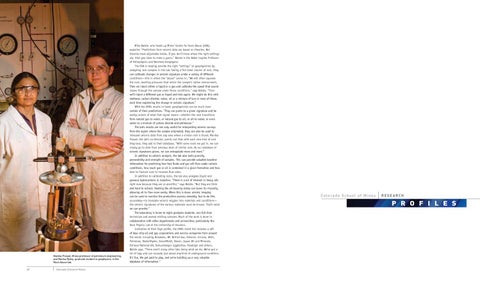Manika Prasad, Mines professor of petroleum engineering, and Marisa Rydzy, graduate student in geophysics, in the Rock Abuse lab. 28
Colorado School of Mines
Mike Batzle, who heads up Mines’ Center for Rock Abuse (CRA), explains: “Predictions from seismic data are based on theories. But theories have adjustable knobs. If you don’t know where the right settings are, then you have to make a guess.” Batzle is the Baker Hughes Professor of Petrophysics and Borehole Geophysics The CRA is helping provide the right “settings” to geophysicists by analyzing rock samples in the lab. Taking a fist-sized column of rock, they can calibrate changes in seismic signature under a variety of different conditions—this is where the “abuse” comes in. “We will often squeeze the rock, exerting pressures that mimic the sample’s native environment. Then we inject either a liquid or a gas and calibrate the speed that sound moves through the sample under those conditions,” says Batzle. “Then we’ll inject a different gas or liquid and test again. We might do this with methane, carbon dioxide, water, oil or a mixture of two or more of these, each time registering the change in seismic signature.” With the CRA’s results in hand, geophysicists can be much more certain of their predictions. “They can point to a given signature and be pretty certain of what that signal means—whether the rock transitions from natural gas to water, or natural gas to oil, or oil to water, or even water to a mixture of carbon dioxide and petroleum.” The lab’s results are not only useful for interpreting seismic surveys from the region where the sample originated, they can also be used to interpret seismic data from any area where a similar rock is found. Manika Prasad, the lab’s co-director, points out that with each new kind of rock they test, they add to their database. “With some rocks we get in, we can simply go to data from previous tests of similar rock. As our database of seismic signatures grows, we can extrapolate more and more.” In addition to seismic analysis, the lab also tests porosity, permeability and strength of samples. This can provide valuable baseline information for predicting how fast fluids and gas will flow under certain conditions, how much gas or oil is contained in a given formation and how best to fracture rock to increase flow rates. In addition to calibrating rocks, the lab also analyzes liquid and gaseous hydrocarbons in isolation. “There is a lot of interest in heavy oils right now because they are so plentiful,” says Batzle. “But they are thick and hard to extract. Heating the oil-bearing strata can lower its viscosity, allowing oil to flow more easily. When this is done, seismic imaging can be used to monitor the production process remotely, but to do this accurately—to translate seismic wiggles into materials and conditions— the seismic signatures of the various materials must be known. That’s what we can provide.” The laboratory is home to eight graduate students, one full-time technician and several visiting scholars. Much of the work is done in collaboration with other departments and universities, particularly the Rock Physics Lab at the University of Houston. Indicative of their high profile, the CRA’s client list includes a raft of blue chip oil and gas corporations and service companies from around the world, including Anadarko, BP, British Gas, Chevron, Encana, Shell, Petrobras, StatoilHydro, ExxonMobil, Devon, Japan Oil and Minerals, Chinese National Oil, Schlumberger, CggVeritas, Paradigm and others. Batzle says, “There aren’t many other labs doing what we do. We’ve got a lot of toys and can recreate just about any kind of underground condition. It’s fun. We get paid to play, and we’re building up a very valuable database of information.”
Colorado School of Mines
RESEARCH
P ro f iles
Energy
and the
Earth
29
